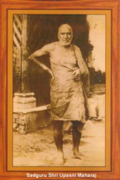By : D. Sankaraiah
 Though Mahatma Gandhi and Sai Baba were contemporaries, they never met in person. After Lokamanya Tilak got blessings of Sai Baba, Gandhi tried to meet Sai Baba but each time, due to pressure of work, to his regret, he could not find time to go to Shirdi.
Though Mahatma Gandhi and Sai Baba were contemporaries, they never met in person. After Lokamanya Tilak got blessings of Sai Baba, Gandhi tried to meet Sai Baba but each time, due to pressure of work, to his regret, he could not find time to go to Shirdi.
Despite the fact that the two never met, they appreciated each other’s thought and work. Sai Baba advised his devotees to “follow the example of Gandhiji in the work of national cause,” To all those who complained of depression, Gandhi advised, ‘Remember God in every living being – whether animal or human. Just as you love me here, love everybody else everywhere, whatever you may be doing anytime, remember to recite the name of Prabhu Ram! Let ‘Rajaram, Rajaram’ be on your lips! Sure, he will look after you!”
It was 1927. Upasani Maharaj at Sakori was very famous. Sai Baba wanted to nominate Upasani Maharaj as his successor. Even though he was a great Mahatma, he did not like to be worshipped on par as Sai Baba and mentally had sought Baba’s permission to decline Sai Baba’s successorship. Out of four years internship fixed by Baba he completed only three years and ten months and left Shirdi.
Gandhi desired to meet Upasani Maharaj and it was Sarojini Naidu who made necessary preparation. About the two, Sarojini Naidu wrote, “We have two mahatmas. One is Upasani Maharaj, who gives us peace. The other is Mahatma Gandhi, who will not let us rest one moment in peace. But each does what he is doing with the same end in view, namely the spiritual regeneration of India”.
 On seeing an eighteen inches high statue of Gandhi in one of the alcoves in Upasani Maharaj ashrama room, one of his devotees was puzzled and asked him, ‘Who should be my ideal?’ ‘Should it be ever active Gandhi, or ever reticent Upasani Maharaj who sits quietly?’
On seeing an eighteen inches high statue of Gandhi in one of the alcoves in Upasani Maharaj ashrama room, one of his devotees was puzzled and asked him, ‘Who should be my ideal?’ ‘Should it be ever active Gandhi, or ever reticent Upasani Maharaj who sits quietly?’
On hearing the question Upasani Maharaj smilingly looked at him and said, “Who told you that I am sitting quietly?” The devotee said that he had been seeing it with his own eyes. At this Upasani Maharaj asked him “Why do you think that what you are seeing with physical eyes is the truth?”
Upasani Maharaj explained to him that both Gandhi and he perform their actions with ‘devotion and detachment’ and ask everyone to do so. They have completely surrendered themselves to divine will. For both, the keyword is ‘surrender’. He said that, if one has surrendered absolutely to God or to a guru like Sai Baba who is Para Brahman himself then he does not have to concern himself about the rectitude or otherwise of the course, he will be taken ‘on the right course’ by the power to whom he has surrendered.
Gandhi, according to Upasani Maharaj was the exemplar of complete and unequivocal surrender to God. Upasani Maharaj upheld that Gandhi had no interest in Indian independence if it were to be achieved by unspiritual or immoral means. Gandhi too admitted several times that he was seeking his own salvation through all his actions.
 Gandhi endorsed the doctrine of ‘surrender’ when he said, ‘And if God guides me, what should I think? Even ‘thought’ may be an obstacle in the way of His guidance.’ Explaining this remark Upasani Maharaj said, “It is only after everything is replaced by ‘divine will.’ all doubts regarding success or failure, right or wrong, disappear. Doubts arise only because one has not surrendered to the divine.”
Gandhi endorsed the doctrine of ‘surrender’ when he said, ‘And if God guides me, what should I think? Even ‘thought’ may be an obstacle in the way of His guidance.’ Explaining this remark Upasani Maharaj said, “It is only after everything is replaced by ‘divine will.’ all doubts regarding success or failure, right or wrong, disappear. Doubts arise only because one has not surrendered to the divine.”
Spiritualism was the cardinal principle underlying all their actions. By ‘spiritualism’ they meant ‘education of the heart’. It represents the ‘inner view of life’ – ‘it is the life within expressing and governing life without,’ Both Gandhi and Upasani Maharaj agreed that ‘the more the soul is in tune with God, the more it realizes its own inner bliss’.
When Upasani attained Mahasamadhi in 1941 Gandhiji cited the episode from Ramayana: that his work on earth was over and paid ‘shraddhanjali’.

Leave a Reply